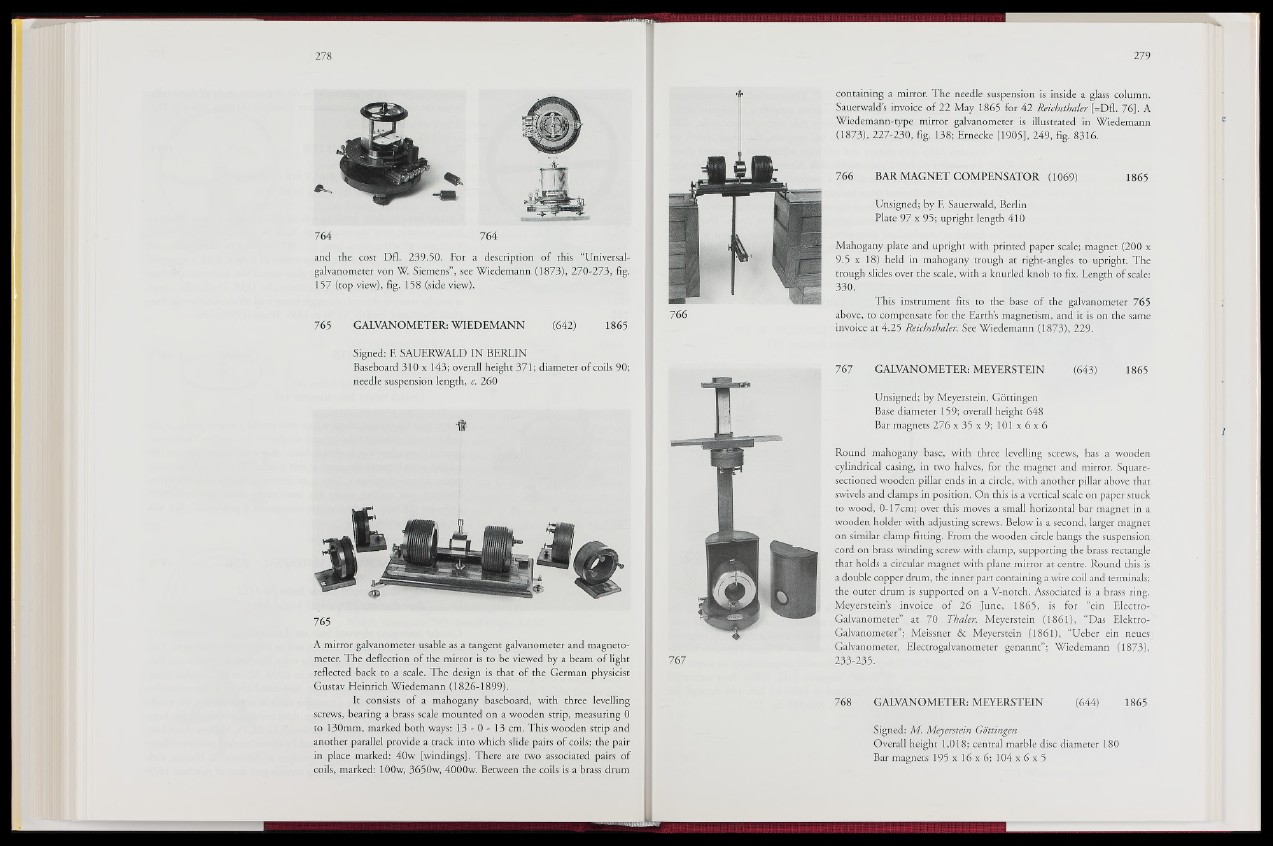
764 764
and the cost Dfl. 239.50. For a description of this “Universal-
galvanometer von W. Siemens”, see Wiedemann (1873), 270-273, fig.
157 (top view), fig. 158 (side view).
765 GALVANOMETER: WIEDEMANN (642) 1865
Signed: F. SAUERWALD IN BERLIN
Baseboard 310 x 143; overall height B l ; diameter of coil®0;
needle suspension length, c. 260
765
A mirror galvanometer usable as a tangent galvanometer and magnetometer.
The deflection of the mirror is to be viewed by a beam of light
reflected back to a scale. The design is that of the German physicist
Gustav Heinrich Wiedemann (1826-1899).
It consists of a mahogany baseboard, with three levelling
screws, bearing a brass scale mounted on a wooden strip, measuring 0
to 130mm, marked both ways: 13 - 0 - 13 cm. This wooden strip and
another parallel provide a track into which slide pairs of coils; the pair
in place marked: 40w [windings]. There are two associated pairs of
coils, marked: lOOw, 3650w, 4000w. Between the coils is a brass drum
iaaaüB'i
containing a mirror. The needle suspension is inside a glass column.
Sauerwald’s invoice of 22 May 1865 for 42 Reichsthaler [=Dfl. 76]. A
Wiedemann-type mirror galvanometer is illustrated in Wiedemann
(1873), 227-230, fig. 138; Ernecke [1905], 249, fig. 8316.
766 BAR MAGNET COMPENSATOR (1069) 1865 :
Unsigned; by F. Sauerwald, Berlin
Plate 97 x 95; upright length 410
Mahogany plate and upright with printed paper scale; magnet §200 x
! |5 x 18) held in mahogany trough at right-angles toifupright. The
trough slides over the scale, with a knurled knob to fix. Length of scale:
330.
This instrument fits to the base of the galvanometer 765 ;
above, to compensate fo|||ffl Earths magnetism, and it is on the same
invoice at 4.25 Reichsthaler. See Wiedemann (1873), 229.
767 GALVANOMETER: MEYERSTEIN (643) 1865
Unsigned; by Meyerstein, Gottingen
Base diameter 159; overall height 648
Bar magnets,2jgi6 x 35 x 9; 101 x 6 x 6 i;|
Round mahoganyf.base, with three levelling screws, has a wooden
cylindrical casing, in two halves, for the magnet and mirror. Square-
sectioned wooden pillar ends in a circle, with another pillar above that)
swivels and clamps in position. On this is a vertical scale on paper stuck
to wood, 0 -l:7aiff;_over this moves a small horizontal bar magnet in a
wooden holder with adjusting screws. Below is a second, larger magnet
on similar clamp fitting. From the wooden c i^ e hangs the suspension
cord on brass winding screw with clamp, supporting the brass rectangle
that holds a circular magnet with plane mirror at centre. Round this is
a double copper drum, the inner part containing a wire coil and terminals;
the outer drum is supported on a V-notch. Associated is a brass ring.
Meyerstein’s invoice of -26 June, 1865, is for “ein Electro-
Gal-^atoometer” at 70 Thaler. Meyerstein ^1861JtkeDas Elekrro-
Galvanometer”; Meissner & Meyerstein (1861), “Ueber ein neues
Galvanometer, Electrogalvanometer genannt”; Wiedemann (1873),
233-235.
768 GALVANOMETER: MEYERSTEIN ( | | | f 1865
Signed: M. Meyerstein Gottingen
Overall heighB,018; central marble disc diameter 180
Bar magnets 195 x 16 x 6; 104 x 6 x 5